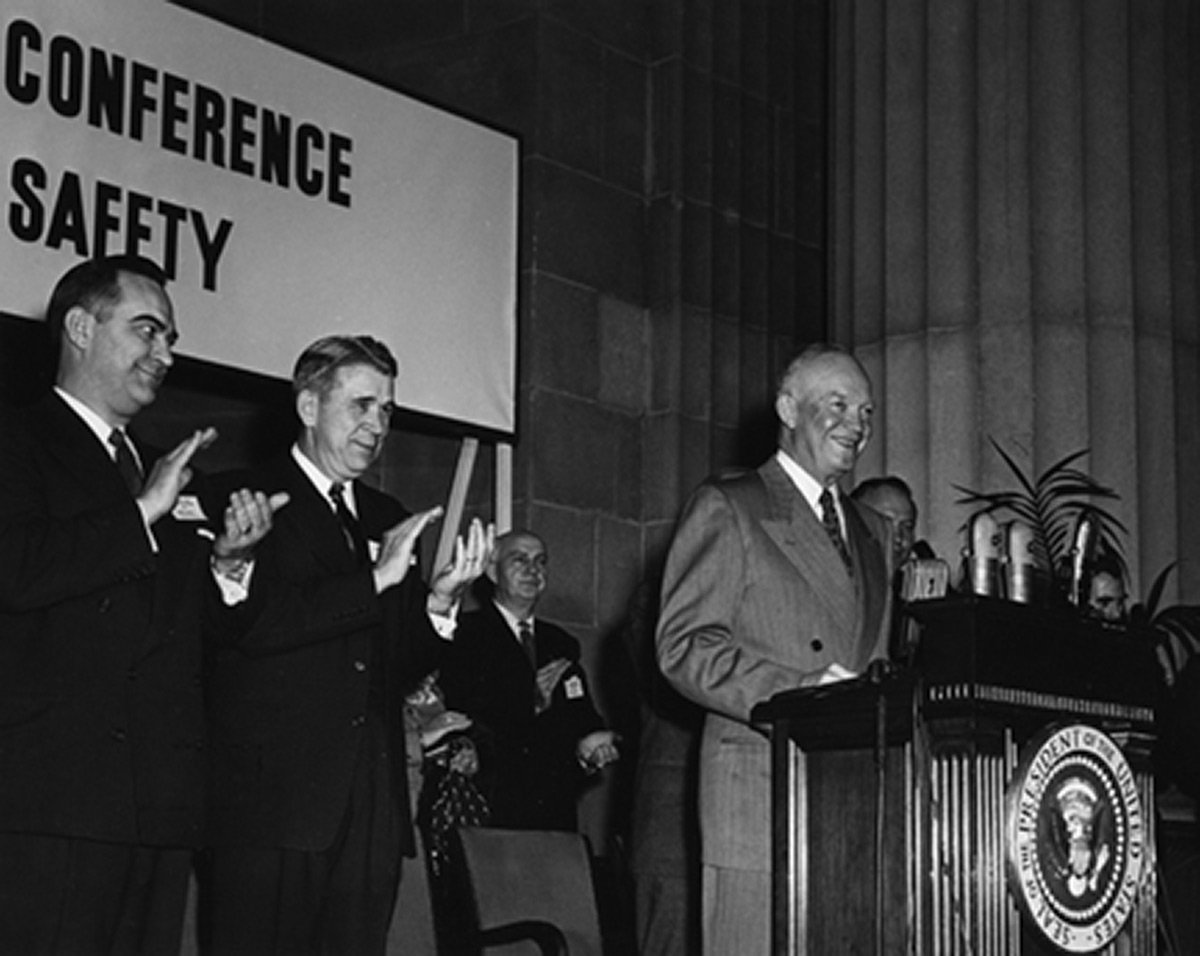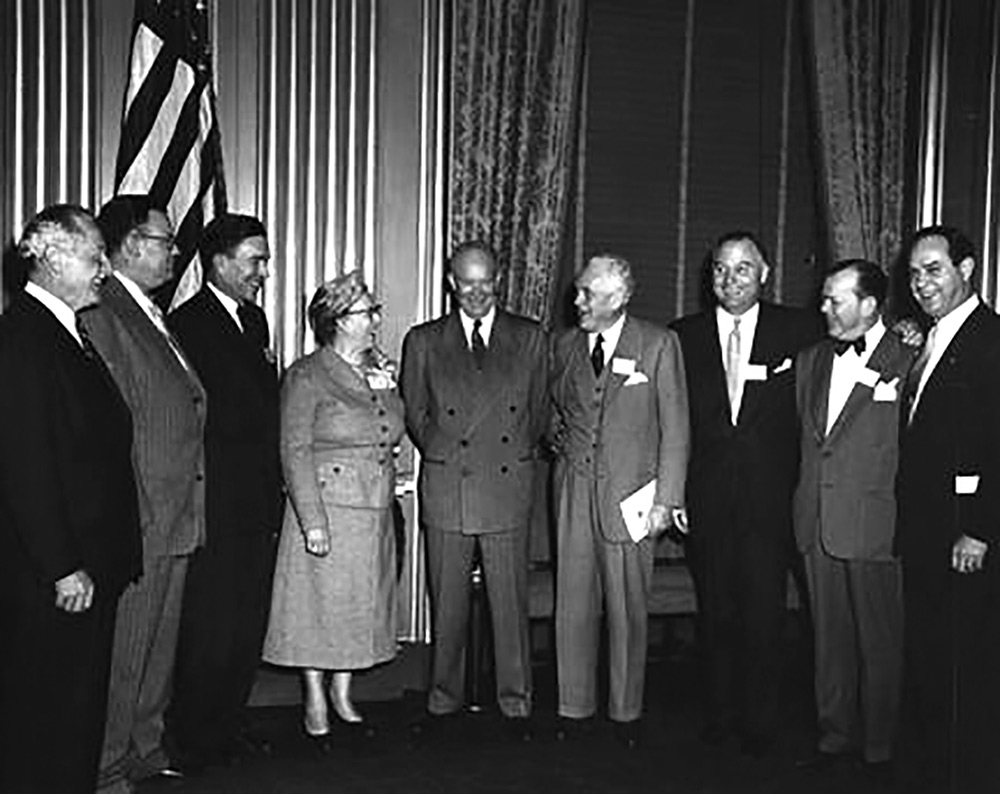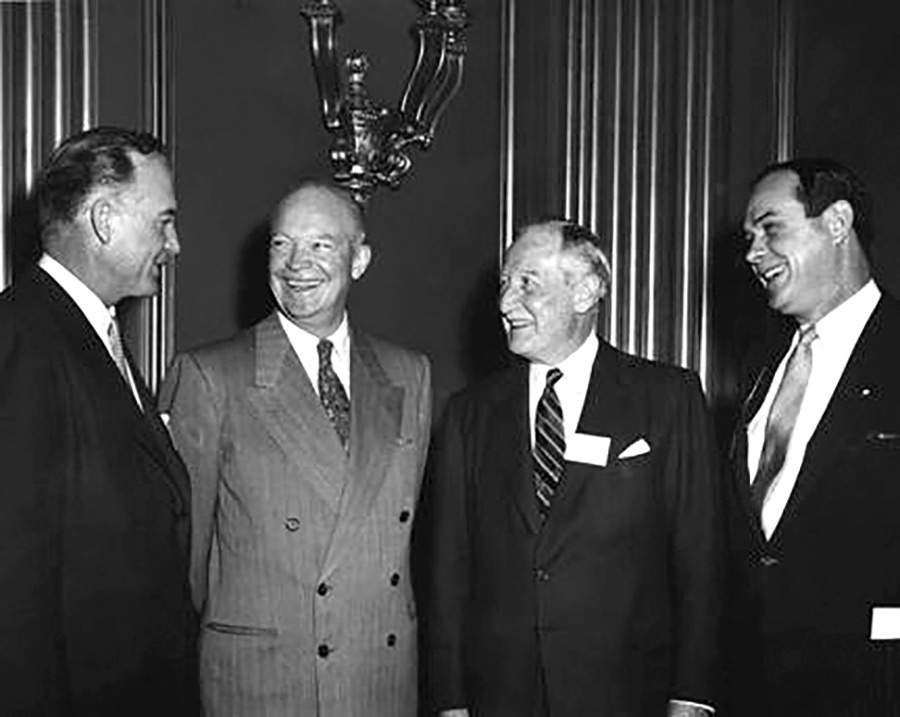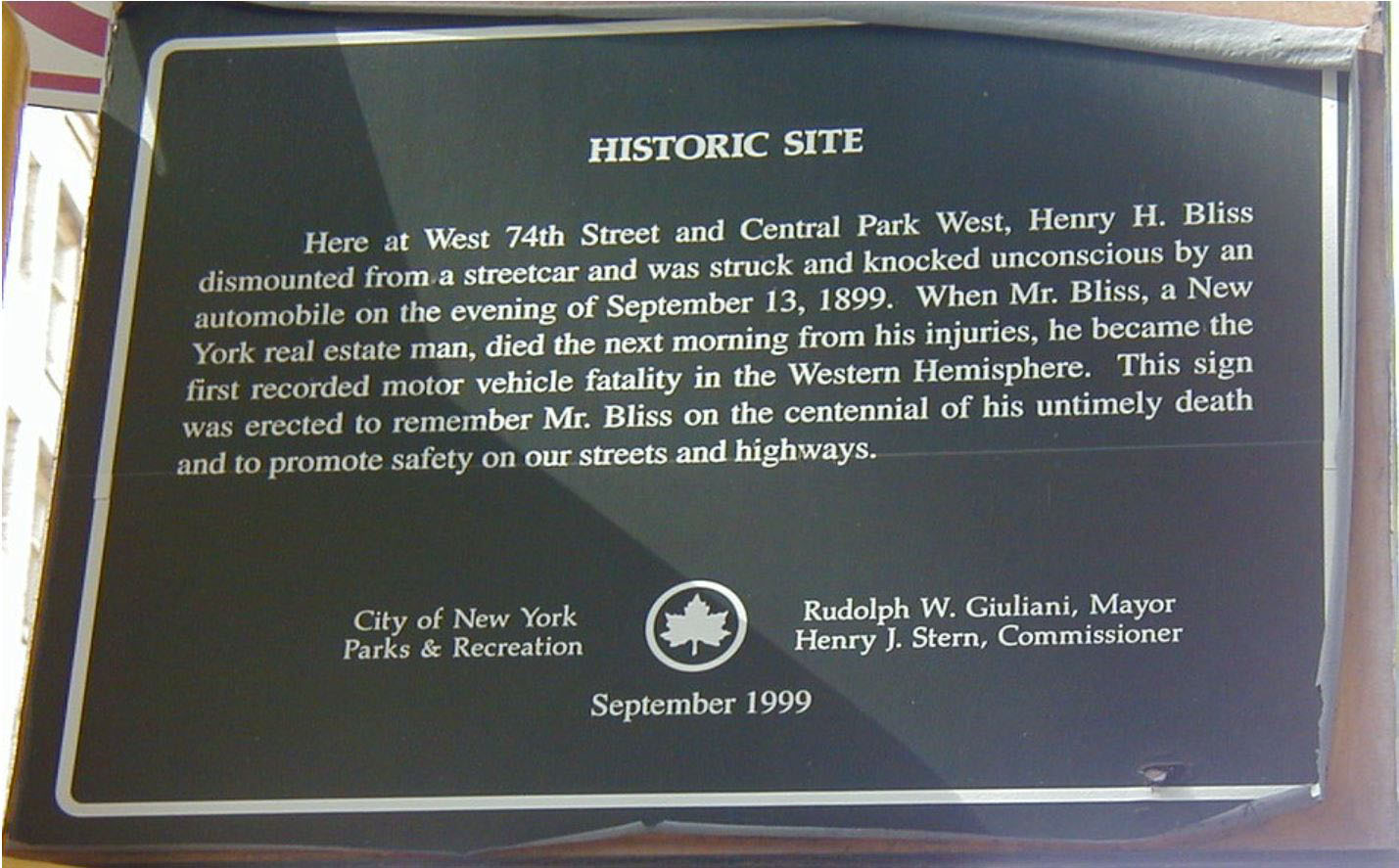A Moment in Time: Safe Driving Day 1954-1955
Public Challenged to go One Full Day without "Accidents"
By Richard Weingroff

The concern about highway safety goes back to the early years of the automobile era. By the 1950s, analysis of the problem came down to the commonly used metaphor of the three-legged stool. One leg was the road, which the State highway agencies, the U.S. Bureau of Public Roads (BPR), and others were always trying to make safer. The second leg was the automobile. The Federal Government did not have the authority to require automakers to design safer vehicles.
The third leg was the driver, also known as “the nut behind the wheel.” Public safety initiatives usually focused on changing driver behavior. Efforts included toughened driver licensing laws, driver education courses in high schools, and public relations campaigns.
But at a moment in time on December 15, 1954, President Dwight D. Eisenhower was the public face of an effort to dramatize highway safety by convincing the country’s drivers – collectively, the nuts in question – to go one full day without accidents. (We now call them “crashes,” but this article will use “accidents,” the term in use at the time.)
Sidebars in this article:

President Eisenhower's Priority
President Eisenhower had expressed concern about highway safety only a few months after taking office on January 20, 1953. In July 1953, he met in the White House with 28 business leaders. According to an account of the meeting, he told them that “he is tired of having three to four times as many persons killed a year on the highways as were killed in Korea.” History, he said, showed that when something is done on a coordinated basis, accidents can be reduced. A truce had saved lives in the Korean War; something similar could be effective on highway accidents.
His goal was to save 17,000 lives and $1.25 billion a year in resulting costs. Following the meeting, the President appointed a 28-member Business Advisory Committee on Prevention of Motor Vehicle Accidents.
The committee held a 3-day Highway Safety Conference in Washington on February 17-19, 1954. On opening day, more than 3,000 delegates were in attendance for President Eisenhower’s speech. He began, “The purpose of your meeting is one that is essentially local or community in character. But when any particular activity in the United States takes 38,000 American lives in one year, it becomes a national problem of the first importance.” In closing, he thanked the delegates for participating in highway safety initiatives in their communities. “I think you are engaged in something – I know you are engaged in something that is not only to the welfare of every citizen of the United States, but I believe that they realize it.”

As announced during the conference, President Eisenhower designated an Action Committee for Traffic Safety in an Oval Office meeting on April 13, 1954. Its eight members included representatives of business, labor, media, agriculture, public officials, and women. (The only woman on the committee, listed as “Mrs. Raymond Sayre” of Iowa, represented women. She was a former President of Associated Countrywomen of America.) BPR’s 1954 annual report explained: “The group was established to coordinate activities of various autonomous national organizations in the traffic-safety field, and to promote effective citizen support, at the community level, for proven methods of improving street and highway safety.” In short, the committee would coordinate the White House’s outreach to the grass roots efforts at the State and local level.
Safe Driving Day
One of the activities that emerged from the 1954 conference was Safe Driving (S-D) Day – a day when no accidents would occur. The President would ask each Governor to proclaim the day and appoint State S-D directors. The first S-D Day was to be held on Wednesday, December 15, 1954.
S-D Day was preceded by 10 days of intensive education through all channels of communication to alert the public and encourage the support of every individual in the country. The National Safety Council (NSC) prepared special materials, such as a booklet titled What You Can Do to Make S-D Day a Success, to convey the idea that traffic accidents can be reduced when all drivers and pedestrians meet their moral and civic responsibilities.
President Eisenhower played a key part in increasing public awareness. On November 16, he issued a statement explaining that the purpose of S-D Day was “to save lives and to prevent injuries. No endeavor could be more worthy of our universal cooperation. None is more urgent.” He hoped that on December 15, every American would help make it a day without “a single traffic accident throughout our entire country.” To accomplish this goal, three things were essential. First, everyone should obey traffic regulations. Second, people should follow common sense rules of good sportsmanship and courtesy. And, third, “let’s each one of us resolve that, either as drivers or as pedestrians, we will stay alert and careful, mindful of the constant possibility of accidents caused by negligence.” In closing, he said, “Let’s make Safe Driving Day an overwhelming success, and our nation’s standard for the future.”
The day before S-D Day, he released a filmed message. “I have a deep conviction that the United States can do anything to which 160 million citizens set their hearts and minds. If we are determined to have a day without a traffic accident in all of America, we can have it.”
The Results
On December 15, President Eisenhower opened a news conference by saying, “Good Morning. I suppose you would expect me to mention that this is Safe Driving Day, and I am really hoping for the very best.” He added, “I hope it is certainly effective.”
The results, however, were not as dramatic as had been hoped. On the comparable Wednesday in 1953 (December 16), 60 people were killed and 1,807 were injured on the Nation’s highways in 4,907 accidents. On S-D Day in 1954, 51 people were killed and 966 were injured in 3,935 crashes. In short, nine fewer people died, and several hundred people avoided injuries. Press Secretary James H. Hagerty told reporters that the President was “quite gratified” by the results, and wanted to thank the media for “playing a part in actually saving lives yesterday.”
There were skeptics. As The New York Times put it, the results “were inconclusive.” The S-D Day campaign may have caused the reduction, but it may have been a random variation with no specific cause. Unnamed experts told the Times, “the basic idea of a safe driving day was unsound.” The only way to make a difference was to promote highway safety year round, not on a specific day. T. T. Wiley, New York City’s Traffic Commissioner, called S-D Day, “an idea that was tried and did not work.”
That single day aside, traffic deaths overall declined from 38,300 in 1953 to 36,300 in 1954 – the lowest total since 1950 despite a 20-percent increase in motor vehicle mileage.
Safe Driving Day, 1955
On August 5, President Eisenhower agreed to participate in the second annual S-D Day planned for Thursday, December 1, 1955. Learning from experience, planners expanded the 1955 S-D Day to include a 21-day period (November 20 to December 11) for a long-range campaign to reduce traffic fatalities. The President was to schedule a national broadcast on November 20 to launch an intensive 10-day campaign on the theme: “Make Every Day S-D Day.” However, on September 24, 1955, the 65-year-old President suffered a heart attack while vacationing in Fraser, Colorado. As a result, he was unable to participate directly in the 1955 campaign. Putting the best face on the situation, highway safety advocates anticipated that the public would rally in greater numbers than ever in honor of the recovering President’s safety initiative.
The President issued a statement on November 30 from his home in Gettysburg, PA. “All over the United States tomorrow, Americans will join in a great National effort to save lives. The occasion will be the second nationwide ‘S-D Day’ – Safe Driving Day.” The goal, he explained, was to have 24 hours without a single accident, but the “long-range, and more important objective is to impress upon all of us the necessity for safe driving and safe walking every day of the year.” The need was “obvious and urgent” because in 1954, “an American man, woman or child was killed in traffic every fifteen minutes.” In 1955, “the record is worse: More people are dying; more are injured and crippled.” Everyone should be concerned by this “tragic situation,” but experiences demonstrated that “traffic accidents can be greatly reduced by proven, year-round safety programs, when these programs have year-round public support.” He concluded:
"I appeal, then, to every American to help demonstrate tomorrow that we can – by our own, personal efforts – reduce accidents on our streets and highways. Having shown that we can do so on one day, let us all, as good citizens, accept our responsibility for safety every day in the future."
The results on the second S-D Day were disappointing, with 89 people killed on the Nation's highways; on the comparable day in 1954, fatalities totaled 81. Rear Admiral Harold Blaine Miller, USN (Retired), Director of the President’s Action Committee, stated: “Disappointing as the S-D Day toll was, we must not lose sight of the fact that ten days still remain in the twenty-one day period” of the campaign.” He hoped the S-D Day campaign’s impact “will be reflected in the twenty-one-day toll.”
As an editorial in The Baltimore Sun explained, “To put it bluntly, S-D Day was a flop.”
Overall, fatalities during the 21-day November-December S-D Day period were lower than in 1954, but that positive result could not erase the fact that fatalities totaled 38,300 in 1955, compared with 36,000 in 1954. In fact, the toll was the highest since 1941, when 39,969 people were killed on the Nation’s highways. Even the S-D Day month of December saw a 12-percent increase over the previous year (3,960 motor vehicle deaths compared with 3,530).
S-D Day 1955 would be the final S-D Day. New approaches would be needed to confront what NSC’s magazine, Public Safety, called this “national disgrace.”
J. W. Bethea, executive secretary of the President’s Action Committee, looked back on S-D Day in an interview with Don Ross for a 1961 series of articles on highway safety in The New York Herald-Tribune:
"This is a great field for gimmicks and panaceas. The President’s Committee even had its own gimmick back in 1954 and 1955 when we promoted Safe Driving Day with a lot of razzmatazz. We tried to encourage every community in the nation to go without a traffic death or even an accident for just one day."
Ross noted that, “The results of the two S. D. Days in terms of deaths and accidents, were not encouraging.” He explained that the President’s committee dropped S-D Day “because it feared, among other things, that the ballyhoo attendant upon it was diverting attention from the balanced program for traffic safety that, in the opinion of traffic specialists, offers the best hope of reducing accidents.”
Back the Attack!
In view of the growing highway safety problem, NSC announced in 1956 that it had launched a new campaign called Back the Attack on Traffic Accidents! The campaign, to take place in December 1956 and all of 1957, was designed “to achieve a balanced traffic control and accident prevention program in every village and hamlet, city and town throughout the land.”
The experience in December 1955 had been instructive. The main factors in traffic accidents had been excessive speed, drinking, darkness, and pedestrian errors. Therefore, Back the Attack was directed at these driver-centric problems. The first phase of the program would attempt to reverse the usually heavy traffic accident toll in December. The second phase would be an all-out attack on traffic accidents in 1957.
President Eisenhower endorsed the program on September 17, 1956, noting that traffic fatalities had been increasing for 18 months. “It is shockingly clear that each of us must assume personal responsibility, not only for driving and walking safety, but for supporting our state and local public officials as they seek to enforce and strengthen our safety programs.” He urged support for the Back the Attack program.
When the results were in, 1956 was the deadliest year to date, up 4 percent from 1955. In all, approximately 40,000 people died on the Nation’s highways, slightly more than the 39,969 who had died in 1941, the previous high total.
On June 29, 1956, President Eisenhower signed the Federal-Aid Highway Act of 1956, which launched the program to construct the Interstate System. As 1957 began, NSC saw the new Interstate System, representing the roadway leg of the three-legged stool, as one of the key factors in maintaining the downward trend of late 1956. On January 4, 1957, NSC sent a letter to its chapters, affiliated councils, and other safety organizations:
"Modernization of the Nation’s roadway system as provided in the Federal Aid Highway Act of 1956 is an important step in meeting the emergency of highway traffic facilitation and traffic safety.
By internal and marginal controls built into the roadway, particularly the control of access to and from adjoining property, coupled with adequate police supervision, accidents and deaths resulting from driver errors can be materially reduced . . . . Compared with older type roads, limited access produces a reduction of from 65 to 75 per cent in traffic deaths.
The National Safety Council supports the need for a modern interstate roadway system of limited access highways, and we recommend that state and local citizen safety organizations take similar position to Back the Attack within their states."
Where the limited access feature was being opposed by economic interests or the State was having difficulty providing its 10-percent share of construction costs for the Interstate System, NSC urged its members to help build “strong citizen support” and provide “tangible proof of support” to State legislatures so that safety gains “may be realized.”
The President’s Greatest Contribution
President Eisenhower remained concerned about highway safety through the remainder of his 8 years in office. During those years, as it turned out, traffic fatalities were the highest in 1955, the year of the second S-D Day. In 1960, his final full year as President, the country experienced 36,399 fatalities. Nevertheless, the annual fatality rate per 100 million miles traveled – the most common way of comparing fatalities over time – declined from 6.65 in 1953 to 5.06 in 1960, his final full year in office.
Looking back on Safe Driving Day, Back the Attack, and other initiatives during President Eisenhower’s two terms, it is clear that his greatest contribution to highway safety occurred when he signed the Federal-Aid Highway Act of 1956. What is now called the Dwight D. Eisenhower National System of Interstate and Defense Highways is the safest highway network in the country, and one of the safest in the world. It has saved tens of thousands of lives, far more injuries, and countless billions of dollars in crash-related costs.
At one moment in time on December 15, 1954, President Eisenhower launched a highway safety program that didn’t live up to the high hopes of its sponsors. At another moment in time, on June 29, 1956, he launched what proved to be, as advertised at the time, the greatest highway safety program in our history.
------
This article is adapted from “President Dwight D. Eisenhower and the Federal Role in Highway Safety,” at https://www.fhwa.dot.gov/infrastructure/safetypr.cfm.
Extras

The President's Action Committee for Traffic Safety
During an Oval Office meeting on April 13, 1954, President Dwight D. Eisenhower held the first meeting of his Action Committee for Traffic Safety. The original members were:
- Harlow H. Curtice, President, GMC, representing business;
- Raymond Leheney, Secretary-Treasurer, Union Label and Service Trades Department, American Federation of Labor, presenting labor;
- Michael J. Quill, President of the United Transportation Workers, Congress of Industrial Organizations, also representing labor;
- Charles F. McCahill, Senior Vice President, Forest City Publishing Company, Cleveland, Ohio, representing media of information;
- Charles B. Shuman, President of the Illinois Agricultural Association, representing agriculture;
- Robert B. Snodgrass, Vice President for local safety organizations of the National Safety Council, representing organizations;
- Mrs. Raymond Sayre of Iowa, past national President, Associated Countrywomen of America, representing women; and
- Governor Dan Thornton, representing public officials.
In a letter that same day to Curtice, the President explained that he did not want to lose the enthusiasm generated by the White House Conference on Traffic Safety. Therefore, he had decided "to have a national committee for traffic safety formed to follow through on the fine work begun by the business group."

The First Traffic Death in the U.S.A.
On September 13, 1899, in New York City, Henry H. Bliss became the first person killed by a motor vehicle, an electric taxi, in the United States. The New York Times carried an article headlined: “Fatally Hurt By Automobile.” It began: “H. H. Bliss, a real estate dealer . . . was run over last night at Central Park West and Seventy-fourth Street. He was injured fatally.”
He had stepped off a trolley car, turned to assist a female companion, and was hit by an electric taxi. “Bliss was knocked to the pavement, and two wheels of the cab passed over his head and body. His skull and chest were crushed.” The passenger in the taxi, Dr. David Orr Edson, “sent in a call to Roosevelt Hospital for an ambulance, and until its arrival did all he could to aid the injured man,” but Bliss died the next day. The taxi driver, Arthur Smith, was charged with manslaughter, but acquitted on the grounds that he had no malice of intent and was not negligent. Bliss was about 68 years old.
This plaque was dedicated at the site 100 years later.
